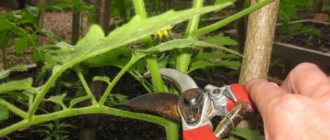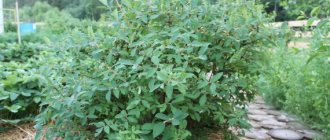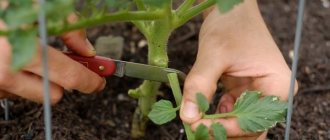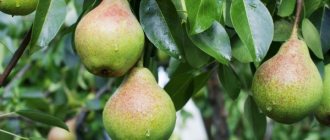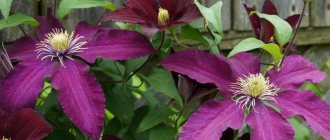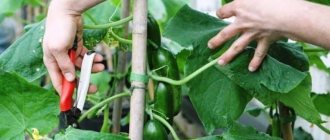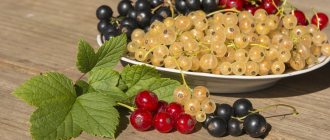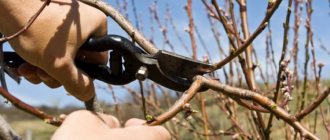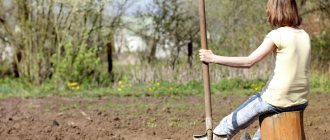Decorative barberry with sharp thorns is today a frequent visitor to summer cottages and garden plots.
What is attractive is not the berries, which have an unusually sour taste, but the spectacular appearance of the bush. But the bush grows incredibly quickly. Therefore, when planting a crop for decorative purposes, regular and correct pruning of barberry is performed. The long-lived plant comes from the countries of the Caucasus and Asia. But thanks to its frost resistance, it is successfully cultivated in the central zone of our country. Barberry is a thorny plant with edible berries. The plant does not require special care; agrotechnical measures during planting and care are kept to a minimum.
Under natural conditions, barberry prefers infertile but dry lands and grows on mountain slopes and near forests. The rhizome of the plant is woody and creeping. Erect shoots reach two or three meters in length and are gray-white, purple, and yellow in color. The elliptical leaves are located on shortened petioles. 2-centimeter spines develop on long branches.
Berry clusters are formed from 15–20 yellowish or bright orange flowers. Long flowering, from April to late May, produces purple or scarlet fruits.
General information about barberry
Barberry is a thorny shrub with edible fruits, native to Asia and the Caucasus. The long-lived plant does not require special care and is used not only to produce healthy berries, but also to decorate plots of land. Despite its southern origin, barberry has sufficient winter hardiness and is successfully grown in central Russia.
Barberry looks very elegant when flowering
There are many varieties of barberry, both deciduous and evergreen. Regardless of the species, they are all armed with the sharpest spines - simple, triple or quintuple. Flowering occurs at a variety of times. For example, Siberian barberry is characterized by early flowering (from mid-May), mid-flowering (late May - early June) by oblong and entire barberry, late (second half of June - early July) by Gerald's barberry and coin barberry.
Most species of barberry are excellent honey plants, as their small yellow flowers are very fragrant and attract bees well. By the end of summer - beginning of autumn, the bushes dress in a bright outfit of berries, which are red, purple, dark blue or black.
Regardless of the variety, the berries are very sour. Nevertheless, they are traditionally used in the preparation of pilaf and other meat dishes.
In autumn, barberry is decorated with bright berries and purple leaves.
The decorative advantages of barberry are preserved throughout the season. In autumn, deciduous barberries have brightly colored leaves and berries that create an extraordinary effect.
When planting barberry in order to obtain a harvest, it is necessary to allocate a well-lit place for the shrub. Barberry is fed starting from the second year, usually with complex fertilizers. The shrub needs little watering - it has excellent drought resistance; watering 3 times per season is enough. Protection against pests usually comes down to the destruction of aphids using, for example, Inta-vir.
Is pruning necessary?
If barberry is given the opportunity to grow freely, the bush gradually “spreads” to the sides due to root shoots. In addition, the growth of the shrub is quite impressive - up to 3-4 m, the branches are spreading, so without regular pruning it will quickly turn your area into a thorny jungle.
Keep in mind that long, sharp thorns can make pruning a bloody undertaking. So it’s worth stocking up on thick gloves and long-handled tools.
The pruning tool must be well sharpened - firstly, because barberry branches are quite strong, and secondly, dull blades can injure them.
Choosing the right tools
For pruning, it is recommended to use special garden pruners or hand scissors. During spring pruning, it is recommended to cut young shoots using hand tools, since after using them there is no damage to the branches, and the pruning is done as accurately and thoroughly as possible.
But for mature plants, you can use electric scissors and chainsaws. Before starting work, you should check the serviceability of the tools.
When trimming bushes, you should use only well-sharpened tools, since dull scissors or pruners can injure the branches and lead to splitting at the ends.
Trim time
Barberry can be pruned in both spring and autumn. Spring is considered the best time for any type of pruning. The main thing is that the procedure must be carried out before the sap flow begins - in March-April.
If you do not want to shape the bush in any special way, then you just need to promptly remove broken and thickening branches, as well as periodically rejuvenate the plant. Deciduous barberries are pruned in early spring, before buds open, and evergreen ones - immediately after flowering. The barberry crown forms quite well on its own - the branches grow almost vertically. In order for the bush to remain in constant shape, you need to eliminate all excess trunks by cutting them into a ring.
For pruning you need to take pruning shears with long handles.
In the fall, you need to have time to finish the “haircut” before frost. But you need to start no earlier than fruiting ends. Autumn pruning, depending on the variety, is carried out in September-October.
It is believed that autumn is good for rejuvenating the bush. Typically, plants are rejuvenated at the age of 10–12 years. In this case, all old trunks are cut out close to the ground. If the bush is too dense, you can also cut out some of the young shoots. In the fall, you can carry out sanitary pruning, as well as remove excess growth.
When to prune barberry - in autumn or spring
To have a well-groomed barberry bush on your site, you need to constantly care for it. Its roots tend to grow quickly and take over free spaces in the garden.
If barberry is not varietal, root growth should be limited.
Having retreated 15-20 cm from the crown, you need to dig the remains of metal-plastic tiles or pieces of iron around the perimeter of the roots to a depth of at least 30 cm. This plant is branched and can reach a height of 5 meters, so pruning should be done annually. Barberry tolerates any haircut well, after which it quickly recovers.
If there are old plants of common barberry on the site, by shaping the crown it can be turned into an exotic plant. Cultivated varieties are formed taking into account the shape of the bred variety.
Pruning barberry depends on its variety and purpose in the garden landscape. It can be carried out in spring, summer, autumn and even winter.
Spring pruning is best for any species. Deciduous varieties of barberry are pruned at the end of winter before the buds open. Cultivated varieties are treated before the start of sap flow, evergreen varieties - after flowering. Hedges and borders are trimmed in summer.
Autumn pruning is carried out after the end of fruiting before the onset of frost. This will allow the plant to avoid the invasion of harmful insects due to better ventilation and more thorough pest control. In spring, the shrub will produce new shoots. Their abundant flowering and fruiting will depend on how to prune the barberry in the fall.
Favorable months
The end of February and mid-March is the best time to prune cultivated species of Thunberg barberry. At this time, it is good to trim young branches for more luxuriant flowering, abundant fruit harvest and to model the crown.
In early July, you should begin trimming hedges and borders made from cultivated varieties of barberry. Shearing continues until mid-August, while young branches grow.
Deciduous varieties of barberry are pruned from mid-February to early March. Old branches are removed, the bush is thinned out at the base so that there is no strong density and the plant receives more sunlight. The tops of young annual branches are cut off to form a crown. In spring they will be covered with lush flowers, and in autumn with many ruby fruits.
We recommend that you read: Pruning raspberries for the winter
Barberry pruning in autumn is carried out from mid-October to the end of November after harvesting. It should be completed before frost begins. Old, broken and growing branches and excess trunks are removed from the plant, cutting them off at the very root. Free the base of the bush from numerous young shoots to give it a well-groomed appearance.
How to form barberry in the first years after planting
Barberry is generally not difficult to prune. Even a beginner can easily cope with this task (unless, of course, he wants to give the bush some exotic shape). In the first year, immediately after planting, all weak shoots are removed, and strong shoots are shortened to a well-developed bud. By autumn the bush gives growth and begins to branch.
The simplest way to form barberry is in three stages, as a result of which a moderately spreading bush is formed
For more abundant branching (giving the bush a rounded shape), in the second year in the spring the shoots are “planted on a stump” - they are cut low, leaving stumps 9–10 cm high. In the fall, a wider, dense crown of young shoots is formed. From the third year this procedure is repeated, but each time the stumps are made higher than in the previous year. You can neglect repeated planting on the stump, and limit yourself only to regular sanitary and thinning pruning.
Barberry reacts calmly to pruning, but you should not shorten the shoots too much, especially if you are counting on a harvest.
Recent Entries
5 working ways to use tar in the garden 7 indoor plants that help you get married even in adulthood Indoor plants that can bloom in trouble
To give it a specific shape, the bush is formed gradually, laying 3-4 skeletal branches in the first year, and in subsequent years, during pruning, leaving 1-2 more main branches. Thus, due to the natural difference in growth, it is possible to form a crown close to a pyramidal one.
Adviсe:
- Don't rush when pruning. Before “shredding” everything, carefully inspect the bush.
- Try to shorten the shoots to a well-developed bud.
- The cuts should be made at a slight angle and as close to the “eye” as possible to avoid stumps.
- The cut surface must be absolutely flat; jamming of the bark and burrs are unacceptable. If they are, it means you are cutting carelessly or using a blunt instrument.
- When removing side shoots, cut directly along the annular growth (the base of the shoot) - if you leave a stump, it will interfere with healing and provoke infections of the plant.
Caring for the plant after pruning
To maintain an attractive and healthy appearance of the barberry bush after pruning, you need to provide it with proper care. It consists of processing the cuts and feeding the plant.
Top dressing
The types of fertilizers needed for shrubs depend on the situation. In the spring, after pruning, the plant needs nitrogen, which is contained in simple organic fertilizers. To do this, it is necessary to distribute an aqueous solution of mature compost around the tree trunk.
In the summer, after formative or sanitary pruning, barberry needs phosphorus and potassium. To do this, feed the plant with stove ash or bone meal. You can also use ready-made mineral fertilizers.
The procedure for decorative formative pruning ends with foliar feeding of the shrub. For these purposes, a liquid solution of potassium humate or an infusion of fermented herbs is used.
How to care for large cuts
If the sections have a diameter of 5-7 millimeters or more, they must be processed correctly. This prevents the penetration of pathogenic bacteria and spores of dangerous fungi.
Immediately after trimming, apply a thin layer of any of the following products to the cut:
- special antiseptic for garden crops;
- garden variety;
- brilliant green solution;
- oil paint.
In such cases, the wood does not rot, and fresh bark grows quickly.
Curly trimming
Although barberry is very thorny, it is easy to form. The type of crown depends entirely on the owner’s imagination - you can form a ball, a pyramid, a column or some kind of geometric figure.
Photo gallery: various forms of barberry bush
Single bushes look very good in the shape of a ball
To create beautiful compositions, you can combine barberry with other plants.
The barberry hedge looks especially elegant in the fall
The required number of trunks will depend on the purpose of the bush. A small number of powerful trunks will be enough if the bush is single. If a hedge is formed from barberry, the number of shoots should correspond to its length and width.
To maintain a given width, it is necessary to remove all trunks growing to the side at the root
To give the barberry bush any specific shape during spring pruning, you need to greatly shorten all annual growths to a length of 5–6 cm. Try to immediately give the contour of the bush the planned shape. During the season, the plant is allowed to form new growth freely. Then, for 3–4 years, the bush is trimmed 2 times a year (before buds open and as growth lengthens). As soon as young shoots reach a length of 8–10 cm, they are shortened by half.
Rectangular or trapezoidal shapes are suitable for forming hedges.
It should be borne in mind that each plant has a tendency towards a certain form. Without pruning, barberry grows in the form of a spreading, disheveled ball. And when cutting, the easiest way is to give it a cone shape.
Of course, out of habit, it is very difficult to trim a bush to a geometric shape. Therefore, it is better to stock up on a template. It is quite possible to make the template yourself. To do this, draw the required contour on some flat surface (for example, on asphalt) and bend a thick wire template along it.
To create a spherical crown, make a template from wire - a semicircle on a “leg”
Then the finished template is inserted into the center of the bush, lightly sticking it into the ground and twisting it around its axis. At the same time, all shoots protruding beyond the contour of the template are cut off.
Using a wire template, you can give the bush a spherical shape
To form a cube or ball, a frame of slats can help, which limit the required dimensions of the bush.
If you create a slatted frame around the bush, you can easily trim it to the desired shape
Thus, if you have simple devices and a certain amount of imagination, you can decorate your site with beautiful bushes of various shapes (and if different varieties of barberry are planted, then also in color).
Video: beautiful pruning of barberry
Types of pruning: timing and features
There are three types of barberry pruning procedures. Each of them has individual characteristics and is performed within a certain time frame.
Sanitary
Sanitary pruning of barberry is of the greatest importance for the plant, since its task is to protect it from diseases and pests. This procedure involves regular thinning of the bush crown and removal of damaged branches.
When planting a barberry bush in the spring in March or April, it is necessary to remove weakened branches and slightly shorten the length of healthy ones.
In the second year of the plant’s life, you need to cut off all the shoots, leaving the stumps at a level of 8-10 centimeters from the soil surface.
In the third year, shoots are again cut 3-5 centimeters higher than with the previous pruning.
See also
Growing and caring for white currants, description of the best varieties
Read
Additional sanitary pruning should be carried out in the fall - September and October are favorable months for this procedure.
Rejuvenating
Barberry bushes that have reached 8-10 years of age and have lost their former decorative appearance require rejuvenating pruning. The procedure is carried out in the spring and consists of completely cutting off the old shoots of the plant. This stimulates the intensive growth of new healthy shoots.
Formative
The formation of the crown should be carried out during the first 4-5 years of the life of the barberry bush. It is preferable to carry out the procedure in summer or early autumn. To give young plants the desired shape, use pruning shears or garden shears.
Formative pruning of mature shrubs is carried out the next year after the rejuvenation procedure, using powerful electric scissors.
When arranging a hedge or plant sculpture in a garden plot, instead of a shaping haircut, a curly haircut is used. This allows you to give barberry bushes a spherical, cubic, pyramidal or cylindrical shape.
